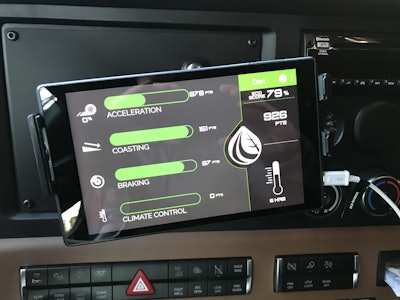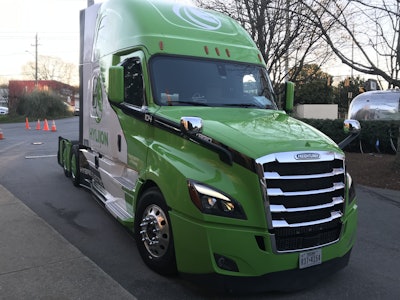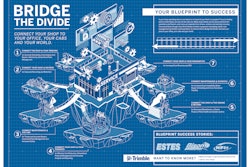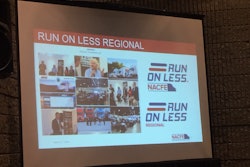 The C0-Pilot driver display screen – mounted to the dash panel to the driver’s right – shows the driver their “score.”
The C0-Pilot driver display screen – mounted to the dash panel to the driver’s right – shows the driver their “score.”The future of trucking is electrified – either parts of the truck or all of it, but electrified nonetheless.
Hyliion and Dana Inc., who earlier this month announced the acquisition of a major stake in the electric drive axle manufacturer, are banking on parts of it. Specifically, the rear axle part.
Hyliion’s 6x4HE kind of converts a 6×2 configuration into a ultra-fuel efficient 6×4. I say kind of because it’s still mostly a 6×2 but with some 6×4 capability. It will give you a little boost at launch but if you’re in the kind of low-traction conditions that 6x2s traditionally hate, the 6x4HE isn’t going to give you much extra bite.
It won’t provide a better start or sprint up a grade, but what it will do is dial up supplemental power – a little extra thrust – and take some of the work off the engine, saving a few bucks at the fuel island.
Hyliion founder and CEO Thomas Healy says the hybrid system can deliver upwards of 15 percent in fuel savings across hilly terrain, which is where the system was engineered to shine. Hill climbs let the electric rear-axle provide that extra push to decrease engine load, keeping RPM at optimal levels for the best-possible fuel consumption. The descent allows the regenerative brake to pump charge back into the batteries. The system is essentially self-sustaining. No solar panels or plug ins. Just friction created by the truck’s own forward movement.
Brand and engine agnostic, the 6X4HE can be installed on any Class 8 truck from any manufacturer. For my quick tour around crowded urban Atlanta this week, it was affixed to a late model Freightliner Cascadia.
Packaged neatly along the frame rails behind the cab, the system adds about 800 pounds to the truck when you factor in the axle trade-out.
The system itself is comprised of four basic components: a 300 amp battery pack; a control unit that, based on the needs of the road’s topography, determines when to capture and when to apply power; a thermal management system that keeps the system at an optimal operating temperature while also providing power for idle-free in-cab climate control capabilities for 10 hours of HVAC and normal hotel loads; the axle itself; and a Co-Pilot display that lets drivers monitor the 6X4HE, provides real-time driving performance feedback and gives the driver the ability to manage the climate control APU feature.

When you combine the fuel economy benefits of the electric hybrid system with those from the APU (12 percent) and a rear aerodynamics package (3 percent), Healy pegs the total fuel savings somewhere around 30 percent.
The 6X4HE acts automatically, using sophisticated learning algorithms to maximize fuel economy. When the system kicks on, it’s hard to describe. The truck just feels lighter and more nimble. You know something is happening because you can feel it, almost like a strong (115 horsepower / 1,500 lb.-ft. torque) tailwind.
Similarly, when the regenerative brake kicks in to capture energy for the system’s batteries, there’s a noticeable drag. I would compare it to Stage 1 engine braking.
By retaining the diesel driveline and enhancing its performance with an electric component, Hyliion has alleviated charging and range concerns while adding a fuel economy kicker that allows for a payback in somewhere around two years depending on duty cycle.
Hyliion’s 6x4HE technology provides a useful entry point into electrification for fleets wary of startup costs and infrastructure buildout.












